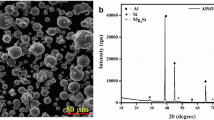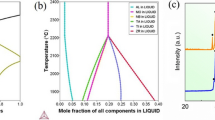Abstract
Porous aluminum alloy with aligned unidirectional pores was fabricated by dipping A1050 tubes into A6061 semi-solid slurry. The porous aluminum alloy was processed through Equal-channel Angular Extrusion (ECAE) while preventing cracking and maintaining both the pore size and porosity by setting the insert material and loading back pressure. The specific compressive yield strength of the sample aged after 13 passes of ECAE was approximately 2.5 times higher than that of the solid-solutionized sample without ECAE. Both the energy absorption EV and energy absorption efficiency ηV after four passes of ECAE were approximately 1.2 times higher than that of the solid-solutionized sample without ECAE. The specific yield strength was improved via work hardening and precipitation following dynamic aging during ECAE. EV was improved by the application of high compressive stress at the beginning of the compression owing to work hardening via ECAE. ηV was improved by a steep increase of stress at low compressive strain and by a gradual increase of stress in the range up to 50 pct of compressive strain. The gradual increase of stress was caused by continuous shear fracture in the metallic part, which was due to the high dislocation density and existence of unidirectional pores parallel to the compressive direction in the structure.










Similar content being viewed by others
References
Banhart, J: Prog. Mater. Sci., 2001, vol. 46, pp. 559-632.
Technical Committee ISO/TC 164: ISO 13314 Mechanical testing of metals, The International Organization for Standardization, Geneva.
Knott, J. F. Mater. Sci. Eng., 1971, vol. 7, pp. 1-36.
Nakajima, H.: Prog. Mater. Sci., 2007, vol. 52, pp. 1091-1173.
Hyun, S. K., Murakami, K. and Nakajima, H.: Mater. Sci., Eng. A, 2001, vol. 299, pp. 241-248.
Segal, V. M., Reznikov, V. I., Drobyshevskiy, A. E. and Kopylov, V. I.: Russ. Metall., 1981, vol. 1, pp. 99-105.
Suzuki, S., Utsunomiya, H., Nakajima, H.: Mater. Sci. Eng. A, 2008, vol. 490, pp. 465-470.
Suganuma, K., Hayashida, T., Yuasa, T. and Suzuki, S.: Key Eng. Mater., 2014, vol. 622-623, pp. 148-154.
Ichikawa, J., Suzuki, S., Hayashida, T., Yahara, R. and Nakae, H.: Mater. Trans., 2012, vol. 53, pp. 1790–1794.
Japan Aluminum Association: Aluminum Hand Book, seventh ed, Japan Aluminum Association, Tokyo, 2007, pp. 32.
T. Motegi, N. Ogawa, K. Kondo, C. Liu, and S. Aoyama: Proc. 6th Int. Conf. on Aluminum Alloys 1, Toyohashi, Japan, 1998, pp. 297–302.
Hayashida, T., Suzuki, S., Ichikawa, J. and Toyoyama, R.: Mater. Trans., 2013, vol. 54, pp. 2102–2108.
Furukawa, M., Iwahashi, Y., Horita, Z., Nemoto, M. and Langdon, T. G.: Mater. Sci. Eng. A, 1998, vol. 257, pp. 328–332.
Kim, W. J., Kim, J. K., Park, T. Y., Hong, S. I., Kim, D. I., Kim, Y. S., and Lee, J. D.: Metall. Mater. Trans. A, 2002, vol. 33, pp. 3155–3164.
Liu, Q., Jansen, D. J. and Hansen, N.: Acta Mater., 1998, vol. 46, pp. 5819–5838.
Iwahashi, Y., Wang, J., Horita, Z., Nemoto, M. and Langdon, T. G.: Scripta Mater., 1996, vol. 35, pp. 143–146.
Kim, W. J. and Wang, J. Y.: Mater. Sci. Eng. A, 2007, vol.464, pp. 23–27.
Song, Y. H., Tane, M. and Nakajima, H.: Scripta Mater., 2011, vol. 64, pp. 797–800.
Acknowledgments
The A6061 billets used in this study were provided by UACJ Corporation. This study was carried out with the support of Grant-in-Aid from The Light Metal Educational Foundation, Inc., Hitachi Metals-Materials Science Foundation, Suzuki Foundation, and Kimura Foundry Co. Ltd.
Author information
Authors and Affiliations
Corresponding author
Additional information
Manuscript submitted October 21, 2017.
Rights and permissions
About this article
Cite this article
Yoshida, T., Muto, D., Tamai, T. et al. Improvement of Strength and Energy Absorption Properties of Porous Aluminum Alloy with Aligned Unidirectional Pores Using Equal-Channel Angular Extrusion. Metall Mater Trans A 49, 2463–2470 (2018). https://doi.org/10.1007/s11661-018-4584-5
Received:
Published:
Issue Date:
DOI: https://doi.org/10.1007/s11661-018-4584-5




